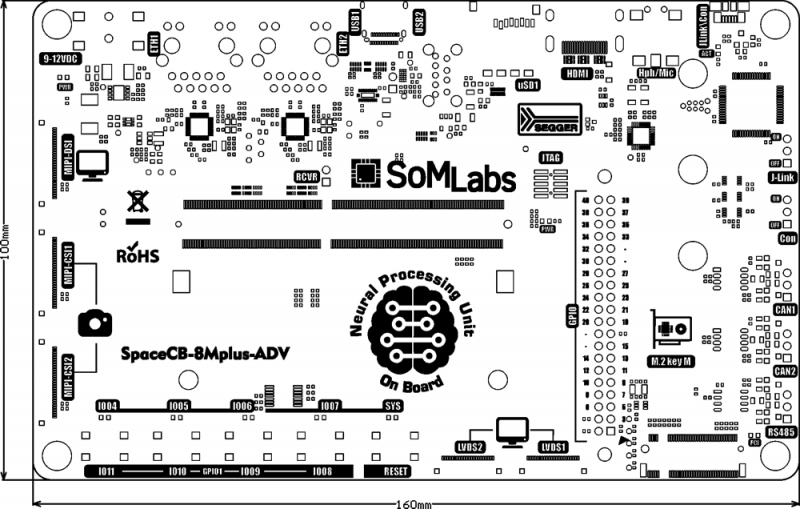SpaceCB-8Mplus-ADV Datasheet and Pinout: Difference between revisions
From SomLabs Wiki
| (43 intermediate revisions by the same user not shown) | |||
| Line 136: | Line 136: | ||
== Important information == | == Important information == | ||
1. The SpaceCB-8M-ADV carrier board is equippped with dual triple-speed 10/100/1000Mb/s Ethernet interface - | 1. The SpaceCB-8M-ADV carrier board is equippped with dual triple-speed 10/100/1000Mb/s Ethernet interface - RTL8211F. Chips are connected to MPU using RGMII interface. | ||
<br>2. The I2C1 interface is common to MIPI-DSI, MIPI-CSI1 and LVDS2 interfaces. | <br>2. The I2C1 interface is common to MIPI-DSI, MIPI-CSI1 and LVDS2 interfaces. | ||
<br>3. The I2C2 interface supports on-board audio codec (NAU88C22YG). | <br>3. The I2C2 interface supports on-board audio codec (NAU88C22YG). | ||
<br>4. The I2C3 interface supports touch-panel controller connected to MIPI-DSI interface (J502). | <br>4. The I2C3 interface supports touch-panel controller connected to MIPI-DSI interface (J502). | ||
<br>5. The I2C4 interface is common to MIPI-CSI2 and LVDS1 interfaces. | <br>5. The I2C4 interface is common to MIPI-CSI2 and LVDS1 interfaces. | ||
<br>6. The I2C6 interface supports PI5USB30213A USB-C interface controller. | <br>6. The I2C6 interface supports PI5USB30213A USB-C interface controller. Both I2C6_SDA and I2C6_SCL lines are equipped with pull-up resistors (4.7kOhm) installed on SpaceSOM-8Mplus and not on SpaceCB-8Mplus-ADV. | ||
<br>7. The SPI1 interface supports display controller connected to LVDS1 (J550). | <br>7. The SPI1 interface supports display controller connected to LVDS1 (J550). | ||
<br>8. The SPI2 interface supports display controller connected to LVDS2 (J551). | <br>8. The SPI2 interface supports display controller connected to LVDS2 (J551). | ||
| Line 569: | Line 569: | ||
| 3 || SD1_SMD || W29 || CMD | | 3 || SD1_SMD || W29 || CMD | ||
|- | |- | ||
| 4 || | | 4 || 1.8/3.3V || - || VDD (uSD power supply)<br>selected internally with SAI5_RXD0 | ||
|- | |- | ||
| 5 || SD1_CLK || W28 || CLK | | 5 || SD1_CLK || W28 || CLK | ||
| Line 583: | Line 583: | ||
</center> | </center> | ||
== | Note: | ||
[[File: | <br>1. Value of VDD for uSD is selected with SAI5_RXD0 (MPU) pin. | ||
<br>- | == USB-C interface == | ||
<br>- | [[File:SpaceCB-8Mplus-ADV-USBC.png|center|700px]] | ||
Note: | |||
<br>1. USB-C interface built-in SpaceCB-8Mplus-ADV is connected to USB1 channel. | |||
<br>2. The I2C6 interface supports configuration of PI5USB30213A USB-C controller. | |||
== USB 3.0 interface == | |||
[[File:SpaceCB-8Mplus-ADV-USB3.png|center|700px]] | |||
USB 3.0 interface built-in SpaceCB-8Mplus-ADV is connected to USB2 channel. | |||
== USB Console Port and Segger J-Link debugger == | == USB Console Port and Segger J-Link debugger == | ||
[[File: | [[File:SpaceCB-8Mplus-ADV-CONSOLE.png|center|700px]] | ||
<center> | <center> | ||
| Line 599: | Line 607: | ||
! style="text-align: center; font-weight: bold;" | Description | ! style="text-align: center; font-weight: bold;" | Description | ||
|- | |- | ||
| CONSOLE-TXD || UART4-TXD || | | CONSOLE-TXD || UART4-TXD || TXD line of console port | ||
|- | |- | ||
| CONSOLE-RXD || UART4-RXD || | | CONSOLE-RXD || UART4-RXD || RXD line of console port | ||
|} | |} | ||
</center> | </center> | ||
| Line 607: | Line 615: | ||
Notes: | Notes: | ||
<br>1. Linux console port (UART4 in MPU) uses vCOM interface provided by built-in debugger Segger J-Link. | <br>1. Linux console port (UART4 in MPU) uses vCOM interface provided by built-in debugger Segger J-Link. | ||
<br>2. vCOM can be disconnected from MPU with | <br>2. vCOM can be disconnected from MPU with jumper CON (position ON or OFF). | ||
<br>3 | <br>3. Debug JTAG interface can be disconnected from MPU with jumper J-LINK (position ON or OFF). | ||
<br>4. J-Link activity is monitored with ACT LED. | |||
<br> | |||
== 24-bit stereo audio codec == | |||
[[File:SpaceCB-8Mplus-ADV-CODEC.png|center|700px]] | |||
The SpaceCB-8M-ADV board is equipped with 24-bit stereo codec - Nuvoton NAU88C22YG - with integrated audio amplifier. | |||
<br>The NAU88C22 is a low power, high quality CODEC for portable and general purpose audio applications. In addition to precision 24-bit stereo ADCs and DACs, NAU88C22YG integrates a broad range of additional functions to simplify implementation of complete audio system solutions. The NAU88C22 includes drivers for speaker, headphone, and differential or stereo line outputs, and integrates preamps for stereo differential microphones,significantly reducing external component requirements. | |||
<center> | <center> | ||
{| class="wikitable" | {| class="wikitable" | ||
! style="text-align: center; font-weight: bold;" | Default MPU pin name | ! style="text-align: center; font-weight: bold;" | Default MPU pin name | ||
! style="text-align: center; font-weight: bold;" | MPU pin | |||
! style="text-align: center; font-weight: bold;" | Description | |||
|- | |- | ||
| | | SAI3_MCLK || AJ20 || Codec master clock | ||
|- | |- | ||
| | | SAI3_TXC || AH19 || Codec BCLK line | ||
|- | |- | ||
| | | SAI3_TXFS || AC16 || Codec FS line | ||
|- | |- | ||
| | | SAI3_TXD || AH18 || Codec input line | ||
|- | |- | ||
| | | SAI3_RXD || AF18 || Codec output line | ||
|- | |- | ||
| | | I2C2_SCL || AH6 || Confguration I2C interface with 4.7kOhm pull-up (3.3V) | ||
|- | |- | ||
| | | I2C1_SDA || AE8 || Confguration I2C interface with 4.7kOhm pull-up (3.3V) | ||
|} | |} | ||
</center> | </center> | ||
== | == Dual CAN-FD serial interface == | ||
[[File: | [[File:SpaceCB-8Mplus-ADV-CANFD.png|center|700px]] | ||
The | The SpaceCB-8Mplus-ADV board is equipped with Microchip CAN-FD with physical layer interfaces MCP2542FD-E/SN, connected to internal CAN1 and CAN2 channels. | ||
<center> | <center> | ||
{| class="wikitable" | {| class="wikitable" | ||
! style="text-align: center; font-weight: bold;" | Signal | |||
! style="text-align: center; font-weight: bold;" | Default MPU pin name | ! style="text-align: center; font-weight: bold;" | Default MPU pin name | ||
! style="text-align: center; font-weight: bold;" | MPU pin | ! style="text-align: center; font-weight: bold;" | MPU pin | ||
|- | |- | ||
| | | CAN1.TX || SPDIF_TX || AE18 | ||
|- | |- | ||
| | | CAN1.RX || SPDIF_RX || AD18 | ||
|- | |- | ||
| | | CAN2.TX || SAI2_RXC || AH16 | ||
|- | |- | ||
| | | CAN2.RX || SAI2_MCLK || AJ15 | ||
| | |||
| | |||
|} | |} | ||
</center> | </center> | ||
== RS-485 semiduplex serial interface == | |||
[[File:SpaceCB-8Mplus-ADV-RS485.png|center|700px]] | |||
The | The SpaceCB-8Mplus-ADV board is equipped with low-voltage RS-485 physical layer interface MAX3485. | ||
<br>The | <br>The RS-485 is connected to default UART2 (TxD, RxD) channel and pins. Transmission control line DE is controlled by MPU GPIO. | ||
<center> | <center> | ||
{| class="wikitable" | {| class="wikitable" | ||
! style="text-align: center; font-weight: bold;" | Signal | |||
! style="text-align: center; font-weight: bold;" | Default MPU pin name | ! style="text-align: center; font-weight: bold;" | Default MPU pin name | ||
! style="text-align: center; font-weight: bold;" | Description | ! style="text-align: center; font-weight: bold;" | Description | ||
|- | |- | ||
| | | RO || UART2_RXD || Data received by MPU | ||
|- | |- | ||
| | | DI || UART2_TXD || Data transmitted by MPU | ||
|- | |- | ||
| | | DE || GPIO5.05 || Transmitter Enable (active high) signal | ||
|} | |} | ||
</center> | </center> | ||
Note: | |||
<br>1. | <br>1. nRE line of MAX3485 is permanently connected to GND. | ||
== | == GPIO header (J702) == | ||
[[File: | [[File:SpaceCB-8Mplus-ADV-GPIO.png|center|700px]] | ||
<br> | |||
<center> | <center> | ||
{| class="wikitable" | {| class="wikitable" | ||
! style="text-align: center; font-weight: bold;" | | ! style="text-align: center; font-weight: bold;" | J702 pin | ||
! style="text-align: center; font-weight: bold;" | Default | ! style="text-align: center; font-weight: bold;" | Default pin name | ||
! style="text-align: center; font-weight: bold;" | Description | ! style="text-align: center; font-weight: bold;" | Description | ||
|- | |- | ||
| | | 1 || - || +3.3V | ||
|- | |||
| 2 || - || +5V | |||
|- | |||
| 3 || I2C1_SDA || I2C interface with 4.7kOhm pull-up (3.3V) | |||
|- | |||
| 4 || - || +5V | |||
|- | |||
| 5 || I2C1_SCL || I2C interface with 4.7kOhm pull-up (3.3V) | |||
|- | |||
| 6 || - || GND | |||
|- | |||
| 7 || GPIO1.04 || - | |||
|- | |||
| 8 || UART3_TXD || - | |||
|- | |||
| 9 || - || GND | |||
|- | |||
| 10 || UART3_RXD || - | |||
|- | |||
| 11 || GPIO1.05 || - | |||
|- | |||
| 12 || I2C3_SCL || I2C interface with 4.7kOhm pull-up (3.3V) | |||
|- | |||
| 13 || GPIO1_06 || - | |||
|- | |||
| 14 || - || GND | |||
|- | |||
| 15 || GPIO1_07 || - | |||
|- | |||
| 16 || NC || Not connected | |||
|- | |- | ||
| | | 17 || - || +3.3V | ||
|- | |- | ||
| | | 18 || NC || Not connected | ||
|- | |- | ||
| | | 19 || ECSPI2_MOSI || - | ||
|- | |- | ||
| | | 20 || - || GND | ||
| | |- | ||
| 21 || ECSPI2_MISO || - | |||
|- | |- | ||
| | | 22 || GPIO1_08 || - | ||
|- | |- | ||
| | | 23 || ECSPI2_SCLK || - | ||
|- | |- | ||
| | | 24 || ECSPI2_CS0 || - | ||
|- | |- | ||
| | | 25 || - || GND | ||
|- | |- | ||
| | | 26 || GPIO1_09 || - | ||
|- | |- | ||
| | | 27 || I2C4_SDA || I2C interface with 4.7kOhm pull-up (3.3V) | ||
|- | |- | ||
| | | 28 || I2C4_SCL || I2C interface with 4.7kOhm pull-up (3.3V) | ||
|- | |- | ||
| | | 29 || NC || Not connected | ||
|- | |- | ||
| | | 30 || - || GND | ||
|- | |- | ||
| | | 31 || NC || Not connected | ||
|- | |- | ||
| | | 32 || GPIO1_10 || - | ||
|- | |- | ||
| | | 33 || I2C3_SDA || I2C interface with 4.7kOhm pull-up (3.3V) | ||
|- | |- | ||
| | | 34 || - || GND | ||
|- | |- | ||
| | | 35 || ECSPI1_MISO || - | ||
|- | |- | ||
| | | 36 || GPIO1_11 || - | ||
|- | |- | ||
| | | 37 || ECSPI1_CS0 || - | ||
|- | |- | ||
| | | 38 || ECSPI1_MOSI || - | ||
|- | |- | ||
| | | 39 || - || GND | ||
|- | |- | ||
| | | 40 || ECSPI1_SCLK || - | ||
|} | |} | ||
</center> | </center> | ||
Note: | Note: | ||
<br>1. | <br>1. The I2C1 interface is common to MIPI-DSI, MIPI-CSI1 and LVDS2 interfaces. | ||
<br>2. The I2C3 interface supports touch-panel controller connected to MIPI-DSI interface (J502). | |||
<br>3. The I2C4 interface is common to MIPI-CSI2 and LVDS1 interfaces. | |||
== User Interface (switches and LEDs) == | == User Interface (switches and LEDs) == | ||
[[File: | [[File:SpaceCB-8Mplus-ADV-UI.png|center|700px]] | ||
| Line 808: | Line 802: | ||
! style="text-align: center; font-weight: bold;" | Description | ! style="text-align: center; font-weight: bold;" | Description | ||
|- | |- | ||
| | | S700 (black, most on the left) || GPIO1_IO11 || - | ||
|- | |- | ||
| | | S701 || GPIO1_IO10 || - | ||
|- | |- | ||
| | | S702 || GPIO1_IO09 || - | ||
|- | |- | ||
| | | S703 (black, most on the right) || GPIO1_IO08 || - | ||
|} | |} | ||
| Line 824: | Line 818: | ||
! style="text-align: center; font-weight: bold;" | Description | ! style="text-align: center; font-weight: bold;" | Description | ||
|- | |- | ||
| | | S704 (red) || Reset || - | ||
|} | |} | ||
| Line 836: | Line 828: | ||
! style="text-align: center; font-weight: bold;" | Description | ! style="text-align: center; font-weight: bold;" | Description | ||
|- | |- | ||
| | | D703 (most on the left) || GPIO1_IO06|| User LED1 buffered with inverter | ||
|- | |- | ||
| | | D702 || GPIO1_IO05 || User LED2 buffered with inverter | ||
|- | |- | ||
| | | D701 || GPIO4_IO04 || User LED3 buffered with inverter | ||
|- | |- | ||
| | | D700 (most on the right) || GPIO1_IO07 || User LED4 buffered with inverter | ||
|} | |} | ||
<b>Note: version 1.1 of the SpaceCB-8Mplus has incorrect LEDs description - IO6 and IO4 are changed on PCB top overlay!</b> | |||
| Line 852: | Line 846: | ||
! style="text-align: center; font-weight: bold;" | Description | ! style="text-align: center; font-weight: bold;" | Description | ||
|- | |- | ||
| | | D704 || SAI2_TXC|| System function monitoring (heartbeat) connected to SAI2_TXC (AH15 pin of MPU) | ||
|- | |- | ||
| | | D705 || - || Power LED (3.3V) | ||
|} | |} | ||
</center> | </center> | ||
== Dimensions == | == Dimensions == | ||
[[File: | [[File:SpaceCB-8Mplus-ADV-v11-dimensions.png|800px|center]] | ||
Latest revision as of 17:10, 15 March 2023

SpaceCB-8Mplus-ADV v.1.1 Datasheet and Pinout
General description
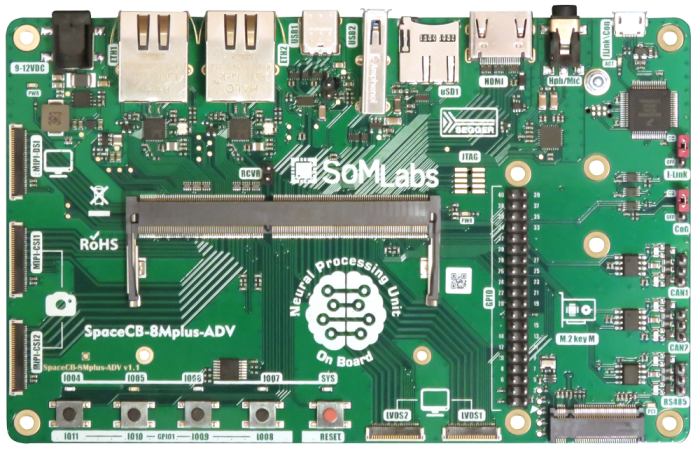
SpaceCB-8Mplus-ADV is a carrier board for the SpaceSOM-8Mplus family of computer-on-modules which are powered by NXP SOC iMX8Mplus (quad core ARM Cortex-A53+ single Cortex-M7 + Neural Processing Unit). A carrier board, together with a System on Module (SoM), makes a complete development platform similar to SBC. The carrier board houses the most common interfaces such as USB 3.0, USB-C, dual gigabit Ethernet, HDMI, PCIe, etc. A large variety of interfaces allows to use it as both a complete development platform or as a stand-alone end-product.
The carrier board connects with the SoM via a standard SODIMM connector.
SpaceCB-8Mplus-ADV carrier board is equipped with HDMI + LVDS + MIPI-DSI video outputs, 24-bit audio codec, PCIe 3.0 (M.2 key M) socket (2242, 2260, 2280), RS-485 and CAN-FD interfaces.
SpaceCB-8Mplus-ADV carrier board is equipped with Segger J-Link debugger and Linux serial console port on USB vCOM.
Applications
- AI and ML applications
- Machine vision equipment
- Robotics
- Human-machine Interfaces (HMI)
- Multimedia
- Video streaming
- Industrial embedded Linux computer
- Home Automation – Smart Home
- IoT gateways
- Residential gateways
Features
- Carrier Board (Base Board) compatible with the SpaceSOM-8Mplus family of modules based on quad core, heterogenous NXP iMX8Mplus application processors
- SoM Interface: SODIMM260
- Debug Interface: built-in Segger J-Link JTAG debugger
- Expansion Connectors:
- Serial communication/GPIO connector 2x8 Pin Header (Male)
- MicroSD card socket
- Communication Connectors:
- PCIe 3.0 (single lane, M.2 key M socket)
- RS-485 (simplex, 3 pin 2.54mm connector)
- 2x CAN-FD (3 pin 2.54mm connector)
- 2x Ethernet 10/100/1000Mbit/s, RJ45
- 1x USB Host 3.0
- 1x USB C
- 1x Console + JTAG MicroUSB B connector
- Display Interface:
- 1x HDMI
- 1x MIPI-DSI (FFP/FPC30)
- 2x LVDS (FFP/FPC22)
- Camera Interface:
- 2x MIPI-CSI2 (FFC/FPC30)
- User Interface:
- 24-bit audio codec
- Line and microphone inputs
- Speaker or headphone outputs
- 4+1 Pushbuttons
- 4+3 LEDs
- External Power Supply 9-12V DC
- Temperature Range: 0 to +70°C
- Board Size: 160mm x 100mm x 25mm
Pictures of SpaceCB-8Mplus-ADV v1.1 board
| Version | Photo |
|---|---|
| SpaceCB-8Mplus-ADV v1.1 board only |
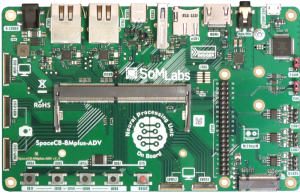 |
| SpaceCB-8Mplus-ADV v1.1 with SpaceSOM-8Mplus |
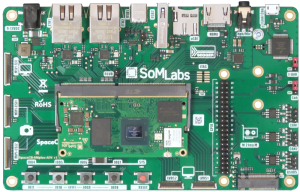 |
| SpaceCB-8Mplus-ADV with SpaceSOM-8Mplus and M.2 SSD drive |
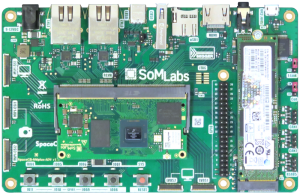 |
Ordering info
Block Diagram
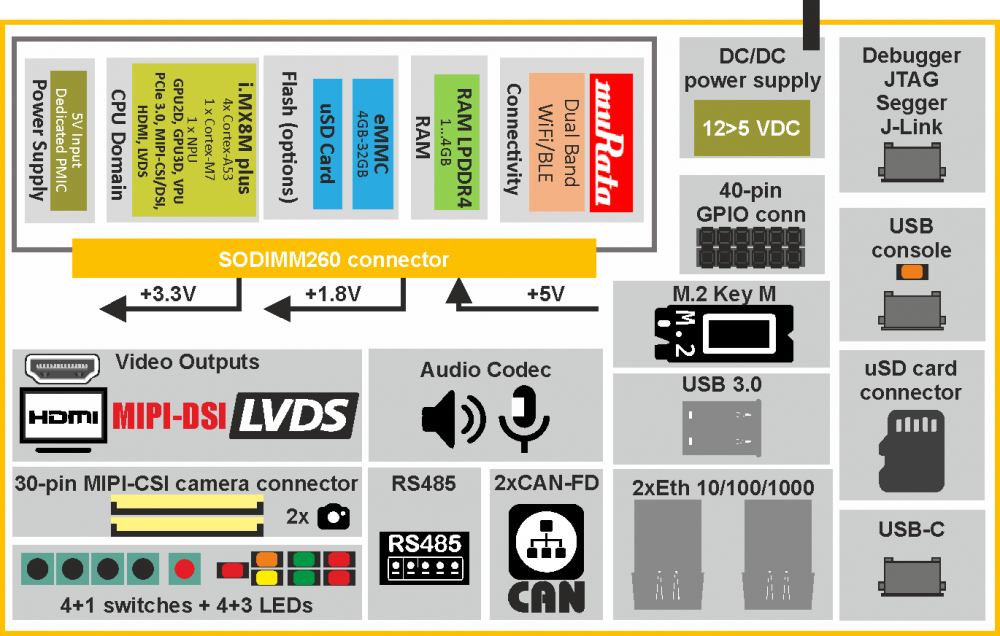
Electrical parameters
| Parameter | Value | Units | Comment | ||
|---|---|---|---|---|---|
| Min. | Typ. | Max. | |||
| Power Supply | 9.0 | 12.0 | 15.0 | V | Positive pole on central connector of J101 |
| Supply current | - | - | 0.8 | A | Excluding LCD, USB and another external loads |
| MIPI-DSI Power Supply (logic) | 3.25 | 3.3 | 3.35 | V | - |
| MIPI-DSI Power Supply (backlight and aux) | 4.85 | 5 | 5.1 | V | - |
| LVDS Power Supply (aux, up to 100mA) |
4.85 | 5 | 5.1 | V | - |
Important information
1. The SpaceCB-8M-ADV carrier board is equippped with dual triple-speed 10/100/1000Mb/s Ethernet interface - RTL8211F. Chips are connected to MPU using RGMII interface.
2. The I2C1 interface is common to MIPI-DSI, MIPI-CSI1 and LVDS2 interfaces.
3. The I2C2 interface supports on-board audio codec (NAU88C22YG).
4. The I2C3 interface supports touch-panel controller connected to MIPI-DSI interface (J502).
5. The I2C4 interface is common to MIPI-CSI2 and LVDS1 interfaces.
6. The I2C6 interface supports PI5USB30213A USB-C interface controller. Both I2C6_SDA and I2C6_SCL lines are equipped with pull-up resistors (4.7kOhm) installed on SpaceSOM-8Mplus and not on SpaceCB-8Mplus-ADV.
7. The SPI1 interface supports display controller connected to LVDS1 (J550).
8. The SPI2 interface supports display controller connected to LVDS2 (J551).
9. All default I2C interface lines (both: SDA and SCL of I2C1, I2C2, I2C3 and I2C4) have pull-up resistors (4.7kOhm).
10. User LEDs and System LED are connected to MPU using buffers with logical inverters.
M.2 socket - key M (PCIe interface, J600)
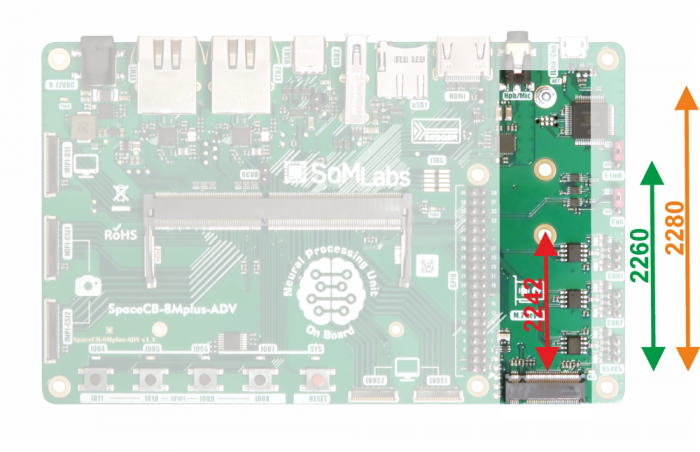
Note:
1. Lines CONFIG0...CONFIG3 of M.2 are permanently connected to +3.3V (CONFIG[3..0]=1111b).
2. Implemented PCIe is single lane interface.
3. M.2 socket is key M type.
Camera MIPI-CSI interface (J500 and J501, FPC/FFC 0.5mm)
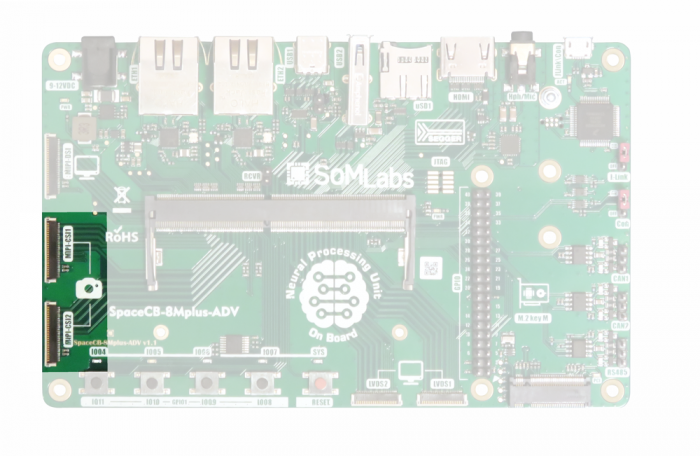
| Pin | Default MPU pin name | MPU pin | Description |
|---|---|---|---|
| 1 | GND | - | - |
| 2 | CSI-CLK-P | - | - |
| 3 | CSI-CLK-P | - | - |
| 4 | GND | - | - |
| 5 | CSI-DATA0-P | - | - |
| 6 | CSI-DATA0-N | - | - |
| 7 | GND | - | - |
| 8 | CSI-DATA1-P | - | - |
| 9 | CSI-DATA1-N | - | - |
| 10 | GND | - | - |
| 11 | CSI-DATA2-P | - | - |
| 12 | CSI-DATA2-N | - | - |
| 13 | GND | - | |
| 14 | CSI-DATA3-P | - | - |
| 15 | CSI-DATA3-N | - | - |
| 16 | GND | - | - |
| 17 | I2C1.SCL | AC8 | Confguration I2C interface with 4.7kOhm pull-up (3.3V) |
| 18 | I2C1.SDA | AH7 | Confguration I2C interface with 4.7kOhm pull-up (3.3V) |
| 19 | GND | - | - |
| 20 | GPIO1_IO0 | A7 | GPIO1.00 (display RES) |
| 21 | GPIO1_IO3 | D6 | GPIO1.03 (dislpay PWRDN) |
| 22 | - | - | - |
| 23 | GND | - | - |
| 24 | +3.3V | - | Power supply for external devices |
| 25 | +3.3V | - | Power supply for external devices |
| 26 | +5V | - | Power supply for external devices |
| 27 | +5V | - | Power supply for external devices |
| 28 | - | - | - |
| 29 | - | - | - |
| 30 | GND | - | - |
| Pin | Default MPU pin name | MPU pin | Description |
|---|---|---|---|
| 1 | GND | - | - |
| 2 | CSI-CLK-P | - | - |
| 3 | CSI-CLK-P | - | - |
| 4 | GND | - | - |
| 5 | CSI-DATA0-P | - | - |
| 6 | CSI-DATA0-N | - | - |
| 7 | GND | - | - |
| 8 | CSI-DATA1-P | - | - |
| 9 | CSI-DATA1-N | - | - |
| 10 | GND | - | - |
| 11 | CSI-DATA2-P | - | - |
| 12 | CSI-DATA2-N | - | - |
| 13 | GND | - | |
| 14 | CSI-DATA3-P | - | - |
| 15 | CSI-DATA3-N | - | - |
| 16 | GND | - | - |
| 17 | I2C4.SCL | AF8 | Confguration I2C interface with 4.7kOhm pull-up (3.3V) |
| 18 | I2C4.SDA | AD8 | Confguration I2C interface with 4.7kOhm pull-up (3.3V) |
| 19 | GND | - | - |
| 20 | UART1_RXD | AD6 | GPIO5.22 (display RES) |
| 21 | UART1_TXD | AJ3 | GPIO5.23 (dislpay PWRDN) |
| 22 | - | - | - |
| 23 | GND | - | - |
| 24 | +3.3V | - | Power supply for external devices |
| 25 | +3.3V | - | Power supply for external devices |
| 26 | +5V | - | Power supply for external devices |
| 27 | +5V | - | Power supply for external devices |
| 28 | - | - | - |
| 29 | - | - | - |
| 30 | GND | - | - |
Note:
1. 1st pins of J500/J501 connectors are at the top of the image.
2. J500 is located on the picture first from above (MIPI-CSI1).
3. The I2C1 interface is common to MIPI-DSI, MIPI-CSI1 and LVDS2 interfaces.
4. The I2C4 interface is common to MIPI-CSI2 and LVDS1 interfaces.
Display MIPI-DSI interface (J502, FPC/FFC 0.5mm)
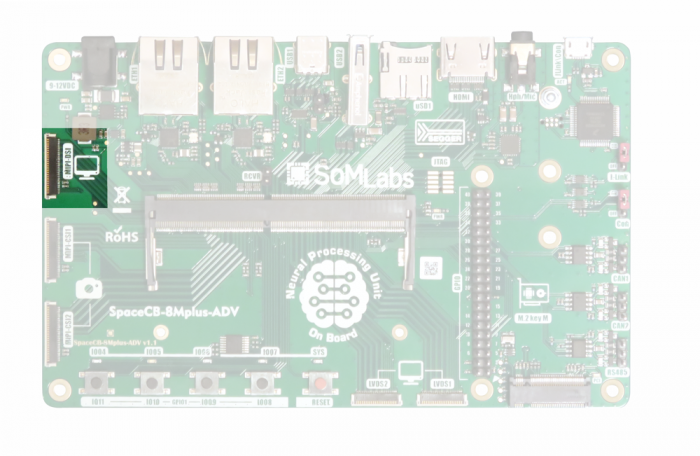
| J502 pin | Default MPU pin name | MPU pin | Description |
|---|---|---|---|
| 1 | GND | - | - |
| 2 | DSI-CLK-P | - | - |
| 3 | DSI-CLK-P | - | - |
| 4 | GND | - | - |
| 5 | DSI-DATA0-P | - | - |
| 6 | DSI-DATA0-N | - | - |
| 7 | GND | - | - |
| 8 | DSI-DATA1-P | - | - |
| 9 | DSI-DATA1-N | - | - |
| 10 | GND | - | - |
| 11 | DSI-DATA2-P | - | - |
| 12 | DSI-DATA2-N | - | - |
| 13 | GND | - | |
| 14 | DSI-DATA3-P | - | - |
| 15 | DSI-DATA3-N | - | - |
| 16 | GND | - | - |
| 17 | I2C1.SCL | AC8 | Display confguration I2C interface with 4.7kOhm pull-up (3.3V) |
| 18 | I2C1.SDA | AH7 | Display confguration I2C interface with 4.7kOhm pull-up (3.3V) |
| 19 | GND | - | - |
| 20 | SAI3_TXC | AH19 | Optional touch-panel reset signal (CODEC.TXC) |
| 21 | I2C3.SDA | F13 | Optional touch-panel interrupt signal |
| 22 | I2C3.SCL | AF9 | Optional touch-panel controller reset |
| 23 | GND | - | - |
| 24 | +3.3V | - | Power supply for external devices |
| 25 | +3.3V | - | Power supply for external devices |
| 26 | +5V | - | Power supply for external devices |
| 27 | +5V | - | Power supply for external devices |
| 28 | GPIO1.01 | E8 | Optional backlight intensity PWM controller |
| 29 | SAI3_TXFS | AC16 | Optional backlight enable (CODEC.TXFS) |
| 30 | GND | - | - |
Note:
1. 1st pin of J502 connector is at the top of the image.
2. For configuration purposes is used I2C1 interface.
3. The I2C1 interface is common to MIPI-DSI, MIPI-CSI1 and LVDS2 interfaces.
4. The I2C3 interface supports touch-panel controller connected to MIPI-DSI interface (J502).
Display HDMI interface (J552)
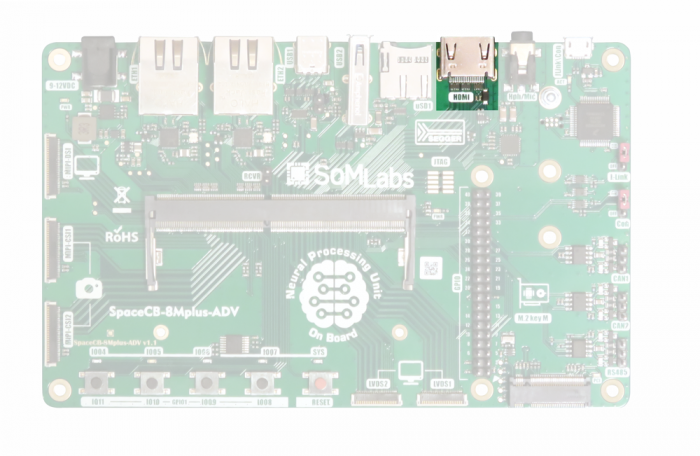
| J552 pin | Default MPU pin name | MPU pin | Description |
|---|---|---|---|
| 1 | HDMI_TX2_P | AH27 | TMDS_D2_P |
| 2 | - | - | GND |
| 3 | HDMI_TX2_N | AJ27 | TMDS_D2_N |
| 4 | HDMI_TX1_P | AH26 | TMDS_D1_P |
| 5 | - | - | GND |
| 6 | HDMI_TX1_N | AJ26 | TMDS_D1_N |
| 7 | HDMI_TX0_P | AH25 | TMDS_D0_P |
| 8 | - | - | GND |
| 9 | HDMI_TX0_N | AJ25 | TMDS_D0_N |
| 10 | HDMI_TXC_P | AH24 | TMDS_CLK_P |
| 11 | - | - | GND |
| 12 | HDMI_TXC_N | AJ24 | TMDS_CLK_N |
| 13 | HDMI_CEC | AD22 | CEC |
| 14 | EARC_P_UTIL | AJ23 | AUX_P |
| 15 | HDMI_DDC_SCL | AC22 | DDC_CLK |
| 16 | HDMI_DDC_SDA | AF22 | DDC_DAT |
| 17 | - | - | GND |
| 18 | - | - | +5V |
| 19 | EARC_N_HPD | AH22 | HPD/AUX_N |
LVDS display interfaces (J550 and J551, FPC/FFC 0.5mm)
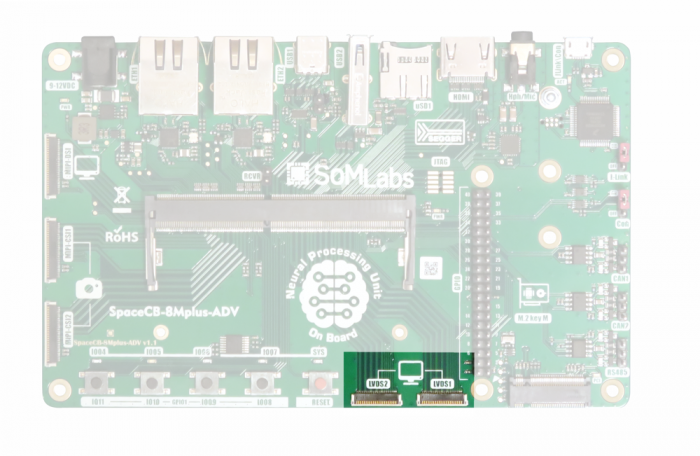
| J550 pin | Default MPU pin name | MPU pin | Description |
|---|---|---|---|
| 1 | GND | - | - |
| 2 | LVDS1.DATA0_N | - | - |
| 3 | LVDS1.DATA0_P | - | - |
| 4 | GND | - | - |
| 5 | LVDS1.DATA1_N | - | - |
| 6 | LVDS1.DATA1_P | - | - |
| 7 | GND | - | - |
| 8 | LVDS1.DATA2_N | - | - |
| 9 | LVDS1.DATA2_P | - | - |
| 10 | GND | - | - |
| 11 | LVDS1.CLK_N | - | - |
| 12 | LVDS1.CLK_P | - | - |
| 13 | GND | - | |
| 14 | LVDS1.DATA3_N | - | - |
| 15 | LVDS1.DATA3_P | - | - |
| 16 | ECSPI1_MOSI | AC20 | Backlight on/off |
| 17 | ECSPI1_MISO | AD20 | Backlight brightness control (PWM) |
| 18 | ECSPI1_CS0 | AE20 | For optional use |
| 19 | I2C4.SCL | AF8 | Touch-panel confguration I2C interface with 4.7kOhm pull-up (3.3V) |
| 20 | I2C4.SDA | AD8 | Touch-panel confguration I2C interface with 4.7kOhm pull-up (3.3V) |
| 21 | +5V | - | Power supply for external devices |
| 22 | +5V | - | Power supply for external devices |
| J551 pin | Default MPU pin name | MPU pin | Description |
|---|---|---|---|
| 1 | GND | - | - |
| 2 | LVDS2.DATA0_N | - | - |
| 3 | LVDS2.DATA0_P | - | - |
| 4 | GND | - | - |
| 5 | LVDS2.DATA1_N | - | - |
| 6 | LVDS2.DATA1_P | - | - |
| 7 | GND | - | - |
| 8 | LVDS2.DATA2_N | - | - |
| 9 | LVDS2.DATA2_P | - | - |
| 10 | GND | - | - |
| 11 | LVDS2.CLK_N | - | - |
| 12 | LVDS2.CLK_P | - | - |
| 13 | GND | - | |
| 14 | LVDS2.DATA3_N | - | - |
| 15 | LVDS2.DATA3_P | - | - |
| 16 | ECSPI2_CS0 | AJ22 | Backlight on/off |
| 17 | ECSPI2_MOSI | AJ21 | Backlight brightness control (PWM) |
| 18 | ECSPI2_MISO | AH20 | For optional use |
| 19 | I2C1.SCL | AC8 | Touch-panel confguration I2C interface with 4.7kOhm pull-up (3.3V) |
| 20 | I2C1.SDA | AH7 | Touch-panel confguration I2C interface with 4.7kOhm pull-up (3.3V) |
| 21 | +5V | - | Power supply for external devices |
| 22 | +5V | - | Power supply for external devices |
Note:
1. 1st pins of LVDS connectors are located on the left.
2. The I2C1 interface is common to MIPI-DSI, MIPI-CSI1 and LVDS2 interfaces.
3. The I2C4 interface is common to MIPI-CSI2 and LVDS1 interfaces.
MicroSD card connector (J701)
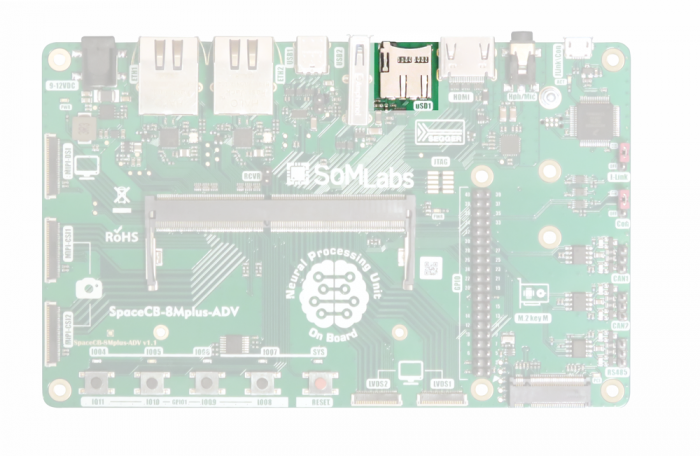
| J701 pin | Default MPU pin name | MPU pin | Description |
|---|---|---|---|
| 1 | SD1_DATA2 | V29 | DATA2 |
| 2 | SD1_DATA3 | V28 | DATA3 |
| 3 | SD1_SMD | W29 | CMD |
| 4 | 1.8/3.3V | - | VDD (uSD power supply) selected internally with SAI5_RXD0 |
| 5 | SD1_CLK | W28 | CLK |
| 6 | - | - | GND |
| 7 | SD1_DATA0 | Y29 | DATA0 |
| 8 | SD1_DATA1 | Y28 | DATA1 |
| SW | SD1_RESET_B | W25 | Card Detect |
Note:
1. Value of VDD for uSD is selected with SAI5_RXD0 (MPU) pin.
USB-C interface
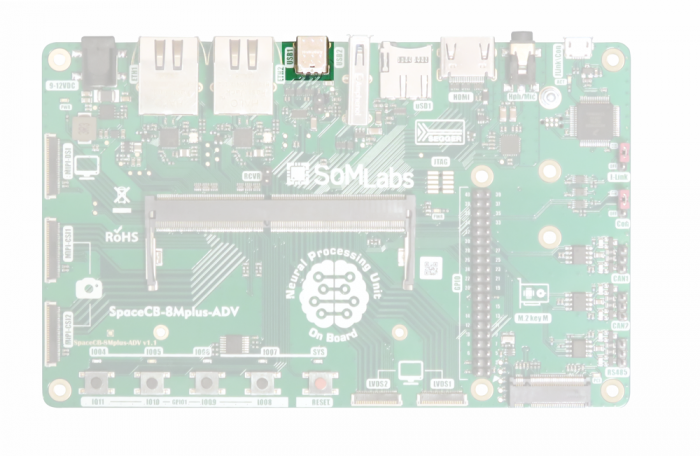
Note:
1. USB-C interface built-in SpaceCB-8Mplus-ADV is connected to USB1 channel.
2. The I2C6 interface supports configuration of PI5USB30213A USB-C controller.
USB 3.0 interface
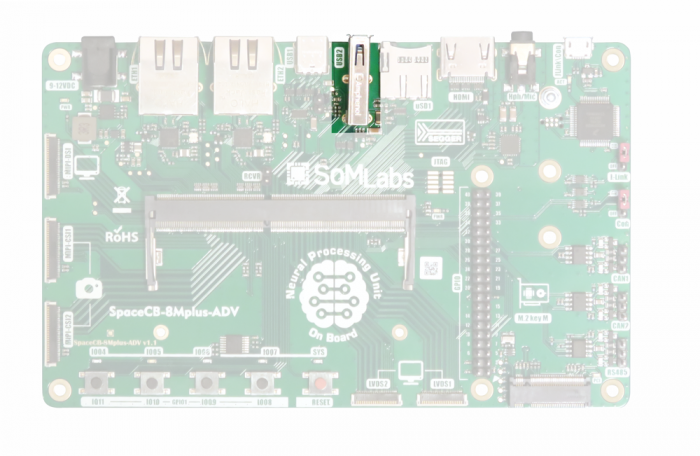
USB 3.0 interface built-in SpaceCB-8Mplus-ADV is connected to USB2 channel.
USB Console Port and Segger J-Link debugger
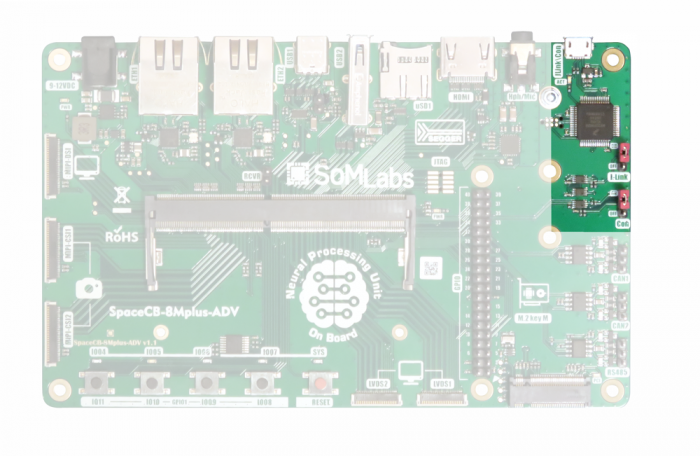
| MPU Port | Default MPU pin name | Description |
|---|---|---|
| CONSOLE-TXD | UART4-TXD | TXD line of console port |
| CONSOLE-RXD | UART4-RXD | RXD line of console port |
Notes:
1. Linux console port (UART4 in MPU) uses vCOM interface provided by built-in debugger Segger J-Link.
2. vCOM can be disconnected from MPU with jumper CON (position ON or OFF).
3. Debug JTAG interface can be disconnected from MPU with jumper J-LINK (position ON or OFF).
4. J-Link activity is monitored with ACT LED.
24-bit stereo audio codec
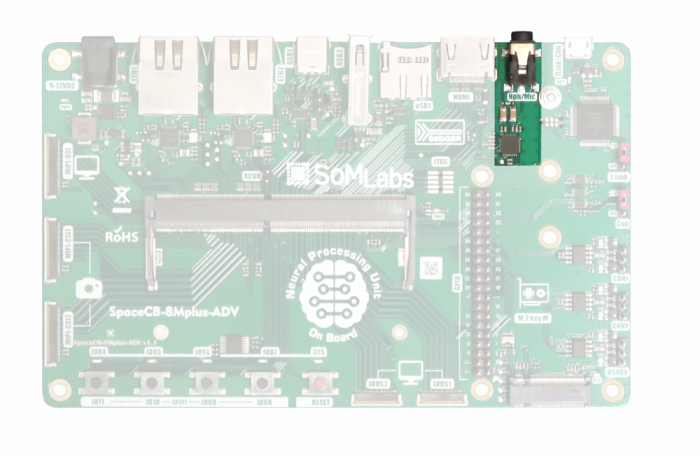
The SpaceCB-8M-ADV board is equipped with 24-bit stereo codec - Nuvoton NAU88C22YG - with integrated audio amplifier.
The NAU88C22 is a low power, high quality CODEC for portable and general purpose audio applications. In addition to precision 24-bit stereo ADCs and DACs, NAU88C22YG integrates a broad range of additional functions to simplify implementation of complete audio system solutions. The NAU88C22 includes drivers for speaker, headphone, and differential or stereo line outputs, and integrates preamps for stereo differential microphones,significantly reducing external component requirements.
| Default MPU pin name | MPU pin | Description |
|---|---|---|
| SAI3_MCLK | AJ20 | Codec master clock |
| SAI3_TXC | AH19 | Codec BCLK line |
| SAI3_TXFS | AC16 | Codec FS line |
| SAI3_TXD | AH18 | Codec input line |
| SAI3_RXD | AF18 | Codec output line |
| I2C2_SCL | AH6 | Confguration I2C interface with 4.7kOhm pull-up (3.3V) |
| I2C1_SDA | AE8 | Confguration I2C interface with 4.7kOhm pull-up (3.3V) |
Dual CAN-FD serial interface
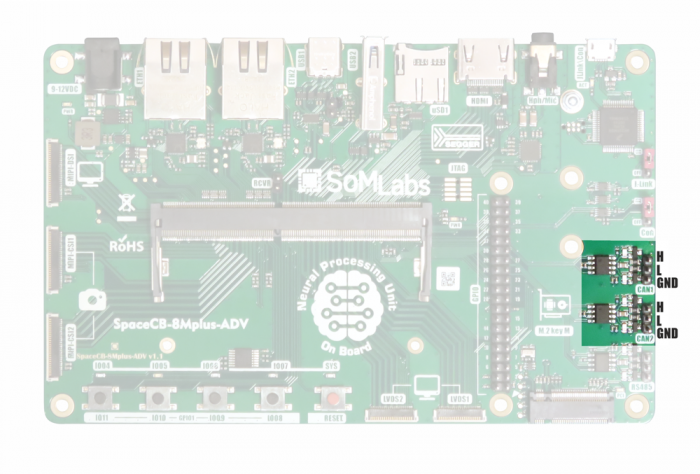
The SpaceCB-8Mplus-ADV board is equipped with Microchip CAN-FD with physical layer interfaces MCP2542FD-E/SN, connected to internal CAN1 and CAN2 channels.
| Signal | Default MPU pin name | MPU pin |
|---|---|---|
| CAN1.TX | SPDIF_TX | AE18 |
| CAN1.RX | SPDIF_RX | AD18 |
| CAN2.TX | SAI2_RXC | AH16 |
| CAN2.RX | SAI2_MCLK | AJ15 |
RS-485 semiduplex serial interface
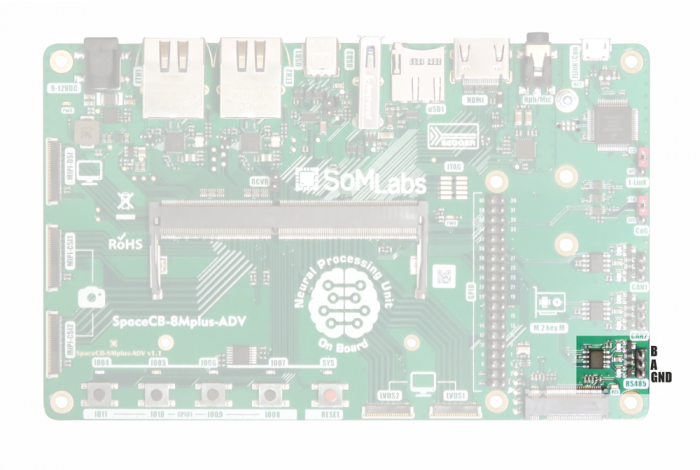
The SpaceCB-8Mplus-ADV board is equipped with low-voltage RS-485 physical layer interface MAX3485.
The RS-485 is connected to default UART2 (TxD, RxD) channel and pins. Transmission control line DE is controlled by MPU GPIO.
| Signal | Default MPU pin name | Description |
|---|---|---|
| RO | UART2_RXD | Data received by MPU |
| DI | UART2_TXD | Data transmitted by MPU |
| DE | GPIO5.05 | Transmitter Enable (active high) signal |
Note:
1. nRE line of MAX3485 is permanently connected to GND.
GPIO header (J702)
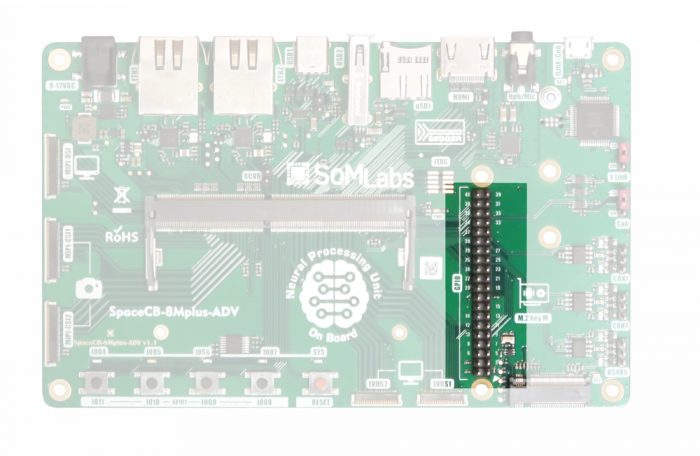
| J702 pin | Default pin name | Description |
|---|---|---|
| 1 | - | +3.3V |
| 2 | - | +5V |
| 3 | I2C1_SDA | I2C interface with 4.7kOhm pull-up (3.3V) |
| 4 | - | +5V |
| 5 | I2C1_SCL | I2C interface with 4.7kOhm pull-up (3.3V) |
| 6 | - | GND |
| 7 | GPIO1.04 | - |
| 8 | UART3_TXD | - |
| 9 | - | GND |
| 10 | UART3_RXD | - |
| 11 | GPIO1.05 | - |
| 12 | I2C3_SCL | I2C interface with 4.7kOhm pull-up (3.3V) |
| 13 | GPIO1_06 | - |
| 14 | - | GND |
| 15 | GPIO1_07 | - |
| 16 | NC | Not connected |
| 17 | - | +3.3V |
| 18 | NC | Not connected |
| 19 | ECSPI2_MOSI | - |
| 20 | - | GND |
| 21 | ECSPI2_MISO | - |
| 22 | GPIO1_08 | - |
| 23 | ECSPI2_SCLK | - |
| 24 | ECSPI2_CS0 | - |
| 25 | - | GND |
| 26 | GPIO1_09 | - |
| 27 | I2C4_SDA | I2C interface with 4.7kOhm pull-up (3.3V) |
| 28 | I2C4_SCL | I2C interface with 4.7kOhm pull-up (3.3V) |
| 29 | NC | Not connected |
| 30 | - | GND |
| 31 | NC | Not connected |
| 32 | GPIO1_10 | - |
| 33 | I2C3_SDA | I2C interface with 4.7kOhm pull-up (3.3V) |
| 34 | - | GND |
| 35 | ECSPI1_MISO | - |
| 36 | GPIO1_11 | - |
| 37 | ECSPI1_CS0 | - |
| 38 | ECSPI1_MOSI | - |
| 39 | - | GND |
| 40 | ECSPI1_SCLK | - |
Note:
1. The I2C1 interface is common to MIPI-DSI, MIPI-CSI1 and LVDS2 interfaces.
2. The I2C3 interface supports touch-panel controller connected to MIPI-DSI interface (J502).
3. The I2C4 interface is common to MIPI-CSI2 and LVDS1 interfaces.
User Interface (switches and LEDs)
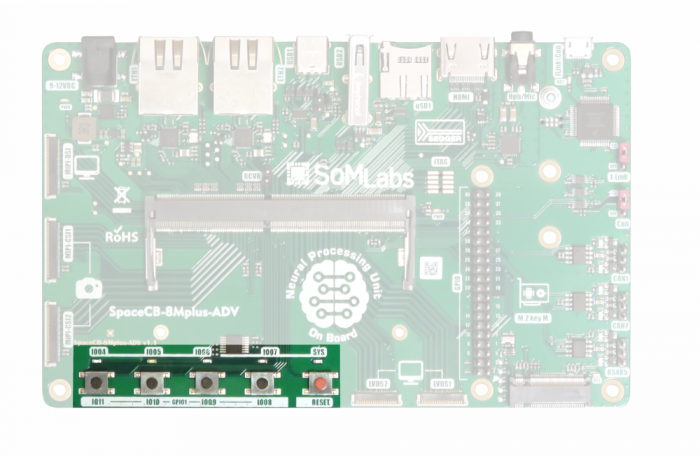
User switches
| Switch | GPIO | Description |
|---|---|---|
| S700 (black, most on the left) | GPIO1_IO11 | - |
| S701 | GPIO1_IO10 | - |
| S702 | GPIO1_IO09 | - |
| S703 (black, most on the right) | GPIO1_IO08 | - |
System switches
| Switch | Signal name | Description |
|---|---|---|
| S704 (red) | Reset | - |
User LEDs
| LED | GPIO | Description |
|---|---|---|
| D703 (most on the left) | GPIO1_IO06 | User LED1 buffered with inverter |
| D702 | GPIO1_IO05 | User LED2 buffered with inverter |
| D701 | GPIO4_IO04 | User LED3 buffered with inverter |
| D700 (most on the right) | GPIO1_IO07 | User LED4 buffered with inverter |
Note: version 1.1 of the SpaceCB-8Mplus has incorrect LEDs description - IO6 and IO4 are changed on PCB top overlay!
System LEDs
| LED | GPIO | Description |
|---|---|---|
| D704 | SAI2_TXC | System function monitoring (heartbeat) connected to SAI2_TXC (AH15 pin of MPU) |
| D705 | - | Power LED (3.3V) |
Dimensions
